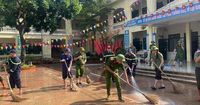As Vietnam faces the brunt of an unusually severe rainy season in October 2025, communities across the country are rallying together in the face of devastating floods and storm damage. In a remarkable display of solidarity, both the armed forces and local authorities have mobilized at record speed to help residents salvage crops, restore infrastructure, and rebuild lives shaken by natural disasters.
In the Đồng Tháp Mười area of Tây Ninh Province, relentless downpours combined with surging waters from the upper Mekong River led to a rapid and dangerous rise in water levels on October 12, 2025. According to PLO, the resulting floods inundated vast stretches of agricultural land, threatening the livelihoods of countless farmers. The region’s rice paddies and fruit orchards—so often the backbone of local economies—were suddenly at risk of being wiped out.
Faced with this urgent crisis, the Tây Ninh armed forces sprang into action. Drawing on the “four-on-the-spot” disaster response principle, they quickly assembled teams of soldiers, local militia, vehicles, and essential equipment. Their mission: to reinforce dykes, help harvest at-risk crops, and do whatever it took to minimize the damage from the floodwaters.
In Vĩnh Châu Commune, the situation was particularly dire. Hundreds of hectares of rice and valuable fruit trees teetered on the brink of destruction. The local military command, led by Mr. Lê Văn Tùng, wasted no time in mobilizing every available hand. “Upon receiving directives from the Party Committee and the Commune People’s Committee to reinforce dykes and prevent overflow from rising floodwaters, our military command quickly mobilized forces, vehicles, and materials for emergency response,” Mr. Tùng told PLO.
At Vĩnh Ân Hamlet, about 200 hectares of rice were still in the critical growth stage, while the Rọc Năng area boasted specialized orchards with high economic value. Under the blazing sun, local militia and residents worked side by side, hauling sacks of earth to the weakest points of the dykes. Their determination was palpable—they were fighting not just for land, but for their very way of life.
For farmers like Đỗ Phước Lộc, who tends five hectares of jackfruit in Vĩnh Ân, the support was nothing short of life-saving. “Thanks to the timely presence of the militia, my family was able to reinforce the entire dyke and protect our orchard. I am grateful to these young men for braving hardship to help us in our time of need,” he said, visibly moved, in comments to PLO.
Elsewhere in Tây Ninh, the story was much the same. On October 10, 2025, police officers teamed up with military units and local residents in Vĩnh Thạnh Commune to rescue 14 hectares of rice fields belonging to brothers Lê Tấn Danh and Lê Thành Công. With floodwaters lapping at their knees, these teams harvested, bundled, and transported rice, forging bonds of camaraderie that will be remembered long after the waters recede.
Meanwhile, hundreds of kilometers to the north, another crisis was unfolding in Trung Giã Commune, Hanoi. Typhoon No. 11 had swept through the area, leaving behind a trail of deep floods, toppled trees, and wrecked infrastructure. Recognizing the scale of the disaster, the Hanoi City Police Party Committee and Command issued a call to action, mobilizing nearly 400 officers and soldiers from multiple units and dispatching them—along with a fleet of specialized vehicles—to the hardest-hit neighborhoods.
“To minimize losses of life and property during the floods, the local government directed forces to coordinate with Hanoi Police, deploying task groups to 15 villages and two schools to quickly implement support measures and overcome the disaster’s aftermath,” explained Nguyễn Thị Thanh Huyền, Vice Chair of the Trung Giã Commune People’s Committee, in remarks reported by Chinhphu.vn.
At Trung Giã A Primary School, the devastation was stark. Classrooms and functional rooms were submerged under nearly a meter of water, forcing the school to close for three days. On the morning of October 12, the Fire Prevention and Rescue Police Department mobilized 80 officers, a fire truck, and six high-capacity pumps to drain the water, scrub the schoolyard clean, and disinfect equipment and furniture. Thanks to their efforts, students from unaffected areas were expected to return to class as soon as October 13.
The response extended far beyond the school gates. Across residential neighborhoods, traffic police, riot police, and youth volunteers split into small groups, going door to door to help families clean their homes, organize belongings, clear debris, and unblock drains. They also tackled the mud and silt that caked the roads, temples, and community centers, working tirelessly to restore a sense of normalcy.
Images of police officers wading through mud and working non-stop in the aftermath of the floods have spread quickly, inspiring a renewed sense of unity and pride. These scenes, as described by Chinhphu.vn, reflect the spirit of “serving the people”—a principle that has guided the capital’s public servants through many crises.
“In recent days, city police forces have remained on duty 24/7 in Trung Giã Commune to support and assist residents, continuing their efforts to overcome difficulties and help people quickly stabilize their lives and restore the environment,” Chinhphu.vn reported. The authorities have pledged that the city’s police will continue to work closely with local disaster defense committees and relevant agencies, maintaining their role as the vanguard in disaster response and recovery.
For many in Vietnam, this past week has been a stark reminder of nature’s unpredictability—and of the importance of community when disaster strikes. From the rice fields of Tây Ninh to the flooded streets of Hanoi, the courage and compassion of local forces and ordinary citizens alike have shone through. Their actions have not only protected crops and property but have also reaffirmed the enduring bonds that tie Vietnam’s communities together, even in the toughest of times.
As the waters slowly recede and the rebuilding begins, these stories of resilience and teamwork will linger, a testament to the power of collective action in the face of adversity.

